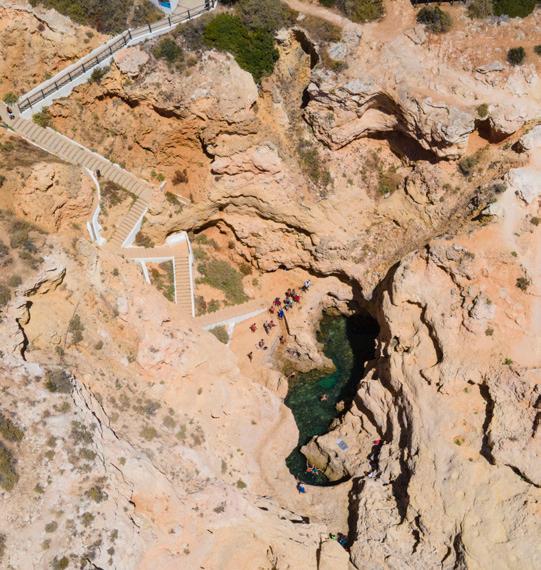
4 minute read
CARVOEIROS CLIFFS
CARVOEIRO’S AMAZING CLIFFS
Join us in exploring the mind boggling cliffs of Carvoeiro, some of the most amazing natural attractions the Algarve has to offer. From the Miradouro da Falesia to the natural pools of Algar Seco, it is without a doubt a must visit!
Advertisement
If you drive along our beautiful Algarvian coast you will come across the charming fishing village of Carvoeiro. A parish slowly developed over time into the well known touristic area it is today, there are still signs of human settlement dating back to the Roman times as well as Naval activity. The region was historically disturbed by pirate and military assaults along its coast with a number of Naval battles known to have occurred, most notably, in 1544, a squadron of ships under D.Pedro da Cunha, battled the Turkish Barbary coast Pirates. From historic records, the earliest occupation found was of Islamic-medieval period and resulted in the village being named “Carboiere” (now Carvoeiro) an old name for a hamlet of fishermen.
The cliff zones in the Algarve are some of the most famous locations in Portugal and the cliffs of Carvoeiro are a prime example of why, with its amazing caves and beaches it used to travel around the world daily on postcards, now they are shared far and wide on social media. The Carvoeiro council built a boardwalk along the cliff edge that leads from the Nossa Senhora da Encarnação fort to the Algar Seco rock formation. This short walk is along an elevated wooden walkway, which skirts the top of the cliffs and offers wonderful views over the stunning coastline and Miradouro da Falesia do Carvoeiro, a stunning group of natural rock pools, caves, windows and archways all carved over an unfathomable amount of time by the elements.

The Algar Seco are a series of fascinating cliff formations that have been carved out of the limestone bedrock. The western side climbs down to a series of rock
formations and honeycomb pitted strata, but more interestingly is the cave fondly known as “A Boneca” (the doll). The short cave passage leads to a small chamber and the most famous viewpoint of Carvoeiro, two eroded arches with views out over the deep blues of the ocean. The “A Boneca” cave name originates from the seaside exterior, which resembles a doll, with the two cave arches forming the eyes of the doll. On the eastern side leads down an exposed sinkhole where the sea waters have penetrated the base and formed a shallow saltwater pool.
The cliffs of this region are carved in massive carbonated rock (limestone) with a high content of marine invertebrates fossils. their age is estimated to be between

24 and 16 million years old. These rocks were formed by the gradual accumulation of marine sediments over millions years. They are extremely vulnerable to water contact, thus being easily carved by it and creating the so called karst landscape. The term karst refers to the relief resulting from the dissolution of limestone by surface and groundwater, the wear of the rock creates even more crevices and cavities, leading to a complex network of wells and galleries. The present landscape of Algar Seco results from the coalescence of several of these cavities and the action of marine erosion. The same complex geomorphology that originated those particular forms, also gave rise to curious structures called “Algar”: vertical shafts connecting the surface to an intricate network of underground galleries


that eventually flow into the sea. The whole mass is crossed by caverns, cracks and cavities of all forms which are shelter to a variety of wildlife, most notably, the cave bats, some as rare as the Moorish horseshoe Bat, which are a valuable asset to the region’s biodiversity. You can frequently see these small mammals in fast and accurate flight around the lamps in the streets and squares, in pursuit of insects which make up a large part of their diet.
If you are planning to take a brave cliff dive into the water be warned, whilst the water might seem incredibly inviting, it is generally very cold as there is no sand bed below to absorb the sun warm up the water so if you have one, bring a wetsuit! The rocks are also incredibly sharp by the waters

edge so a pair of water socks.
If you are a frequent reader of the Simply Algarve magazine then you would have noticed a trend of outdoor focused activities being featured each month, of course we try to focus on outdoor activities during the summer but a big reason is also to provide safe activities during the current climate. Unfortunately, whilst visiting these amazing areas we have noticed a lot of waste (including many face masks) and as much as we like to share these places with our readers we also like to keep our beautiful Algarve beautiful, so please, if you do visit one of the wonderful places featured in the magazine, make sure you clean up after yourself and if possible, others. Thank you and enjoy the beautiful Algarve!










